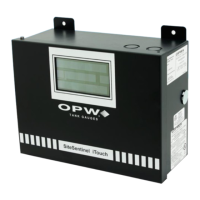13.1.2 Controller Setup for Single-Level Sump Sensor
1. Configure the barrier position to be a generic sensor and install that position.
2. Set the lower alarm threshold to 2.5 volts. Set the upper alarm threshold to 5.0 volts (this will disable
the upper threshold).
3. Program the alarms associated with the lower threshold that will activate if the sensor detects
hydrocarbon liquid.
13.1.3 Testing the Single-Level Sump Sensor
To prevent the possibility of explosion or fire, do not test the sensor in the
Hazardous Area.
Work in a well-ventilated area with no hot surfaces or open flames.
Do not use fuel to test the sensor!
• If the sensor is installed in a normally DRY well:
o Place the float in the UPPER position. An alarm should occur in the Controller.
o Put the float back in the LOWER position. The alarm should end.
• If the sensor is installed in a normally WET well:
o Place the float in the LOWER position. An alarm should occur in the Controller.
o Put the float back in the UPPER position. The alarm should end.
NOTE: If your controller does not sense the alarm conditions simulated here, examine your controller
thresholds to make sure they are correct. Check the orientation of the float as described in the Installation
note above. An alarm should occur when the sensor is disconnected. The Alarm should end when the sensor
is shorted. Examine all wiring and junction boxes to make sure there is continuity without shorts.

